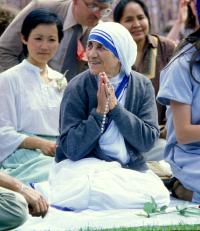Issue Date: October 17, 2003
By RELIGIOUS NEWS SERVICE and The Vatican, possibly at the urging of Pope John Paul II, reportedly considered taking the unprecedented step of declaring Mother Teresa blessed and a saint in a single ceremony. Cardinal Angelo Sodano, the Vatican secretary of state, made the proposal in a letter sent in late spring to cardinals who head Vatican departments, according to Italian news agencies reports Sept. 9. The urging for a move to immediate canonization reportedly came from the head of Mother Teresa’s order, Sr. Nirmala Joshi, in a request to the pope. The reaction, however, was negative. Neither Sodano nor Cardinal Jose Saraiva Martins, prefect of the Congregation for Saints’ Causes, is pushing for a “fast-track” to canonization; both believe many years should pass between a person’s death and the recognition of sainthood -- even for someone as popular as Mother Teresa. Although the pope has the power to act on his own initiative, he apparently was reluctant to go against the advice of the cardinals. It was unclear whether he gave up on the idea or delayed making a final decision. John Paul II will beatify the Albanian-born nun Oct. 19 at a Mass in St. Peter’s Square that will climax a week of celebrations of the 25th anniversary of his election as pope on Oct. 16, 1978. To declare her a saint at the same time would have broken with almost five centuries of tradition. As it is, the widely admired nun, who won the Nobel Peace Prize in 1979 for ministering to “the poorest of the poor,” will be beatified in record time-- little more than six years after her death on Sept. 5, 1997, at the age of 87. John Paul knew and admired Mother Teresa during her life, and it was largely his doing that the Vatican has acted with such speed on the cause for her sainthood. The process normally takes decades, sometimes centuries. And many in the church believe there’s a good reason for that. “Time is important to ensure that there is a move from the faithful recognizing someone as holy to recognizing them as a saint,” that is, a person whose presence with God in heaven is affirmed officially by the church, said he pope’s master of liturgical ceremonies, Bishop Piero Marini. The period between beatification and canonization is the time for that to occur, he said. In the early church, a simple proclamation was all that was required to declare a person a saint, but since the 16th century a candidate must first be declared venerable on proof of his or her “heroic virtues.” Martyrdom or proof of a miracle is then required for beatification, and another miracle, performed after beatification, for canonization. To speed up Mother Teresa’s cause, the pope waived the normal five-year interval between death and the start of the process. He also permitted the examination of a “scientifically unexplainable” miracle attributed to the nun’s intercession to be carried out at the same time as the investigation into her virtues.
National Catholic Reporter, October 17, 2003 |
